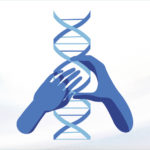A potential danger of CRISPR gene editing — and why base editing may be safer

Gene therapy using CRISPR/Cas9 gene editing is currently in clinical trials around the world for a variety of diseases, including various cancers, blood disorders, and metabolic disorders. It works by making cuts in DNA — both strands of the double helix — to insert or remove genes.
But CRISPR carries a potential, previously undiscovered danger, finds a new Boston Children’s–led study. Researchers led by Roberto Chiarle, MD, and Jianli Tao, PhD, in the Department of Pathology performed multiple runs of classical CRISPR/Cas9 in different human cell lines. They found that CRISPR increased the chance of large rearrangements of DNA. While this was uncommon — occurring up to 5 to 6 percent of the time in the study’s experimental model — such rearrangements can theoretically trigger cancer.
Rogue rearrangements
CRISPR seems to exacerbate a natural process known as retrotransposition, in which DNA sequences known as “mobile elements” or “jumping genes” replicate themselves and move from one location in the genome to another. Similar to CRISPR, these mobile elements use enzymes to create a double-stranded break in DNA where they insert themselves.
Retrotransposition is often harmless — in fact, over the course of evolution, mobile elements have come to make up approximately a third of our genome. (Some scientists believe they are actually ancient viruses.) But mobile elements have also been linked to disease, including cancer. When the breaks they create in DNA aren’t repaired, mismatched ends of DNA can join, leading to rearrangements.
Chiarle, Tao, and colleagues showed that the double-strand DNA breaks that CRISPR introduces can cause mobile elements to insert at the spots CRISPR was meant to target as well as at other unintended locations.
Rethinking CRISPR safety testing
Based on their findings, published June 27 in Nature Communications, the researchers suggest adding a check for retrotransposition to standard safety testing for CRISPR/Cas9 editing systems.
Currently used tests don’t look for the large DNA rearrangements caused by retrotransposition. They either sequence small stretches of DNA to ensure that the desired gene has been added or deleted in the right place or are designed to detect only small gene rearrangements.
The test used in the study identifies retrotransposition events involving LINE-1, the most common mobile element. To create it, Tao refined an existing test called PolyA-seq and set up the experimental system to validate it. “We think this test could help detect these events more reliably, and it may be more cost-effective than the method that’s commercially available,” he says.
Chiarle stresses that their study was purely experimental, done in cells in the laboratory. “We need to determine how often retrotransposition happens in clinical trials of CRISPR gene therapies,” he says. “CRISPR is really a game-changer in genetic therapy, so it’s important to know exactly what it does.”
Base editing: Safer than CRISPR?
Chiarle, Tao, and their colleagues also looked at base editing — a newer, more precise technique that chemically changes just one base or “letter” of the genetic code (C or A) without causing a double-strand break in DNA. Retrotransposition events were much rarer, detected less than 0.01 percent of the time. They were also less frequent during prime editing, an advanced technique that enables targeted insertions, deletions, and all 12 possible base changes.
“We demonstrated that both base editors and prime editors are much safer, with a much lower rate of retrotransposition events than CRISPR/Cas9,” says Chiarle. “While the 5 to 6 percent rate we saw with CRISPR seems small, many gene therapies target millions of cells. For example, in blood disorders, CRISPR may be used to edit a few million blood stem cells, which are then reinfused into the patient. And to initiate a tumor, you may sometimes need just one cell with a transposition event.”
A fast-emerging approach, base editing offers not just greater safety, but greater precision, more predictable editing outcomes, and higher editing efficiency. Boston Children’s recently formed a strategic alliance with Beam Therapeutics, a Cambridge-based biotechnology company to explore base editing in multiple research programs.
The study’s other authors were Qi Wang of Boston Children’s Department of Pathology, and Carlos Mendez-Dorantes and Kathleen Burns of Dana-Farber Cancer Institute. The research was funded by the National Institutes of Health.
Visit the Chiarle Laboratory and learn more about the Department of Pathology’s scientists and clinical services.
Related Posts :
-

Gene therapy’s future may be all about the bases
Gene therapy offers the possibility of a cure for many genetic disorders, especially those involving a single gene. The first ...
-

Genomic 'fingerprinting' yields better treatments for pediatric solid cancers
Genomic profiling is increasingly used for solid tumors in adults and for pediatric brain tumors and blood cancers, allowing treatments ...
-

Gene therapy with a new base editing technique restores hearing in mice
Using a new genetic engineering technique, known as base editing, researchers from Boston Children’s Hospital and the Broad Institute ...
-

After decades of evolution, gene therapy arrives
As early as the 1960s, scientists speculated that DNA sequences could be introduced into patients’ cells to cure genetic disorders. ...





